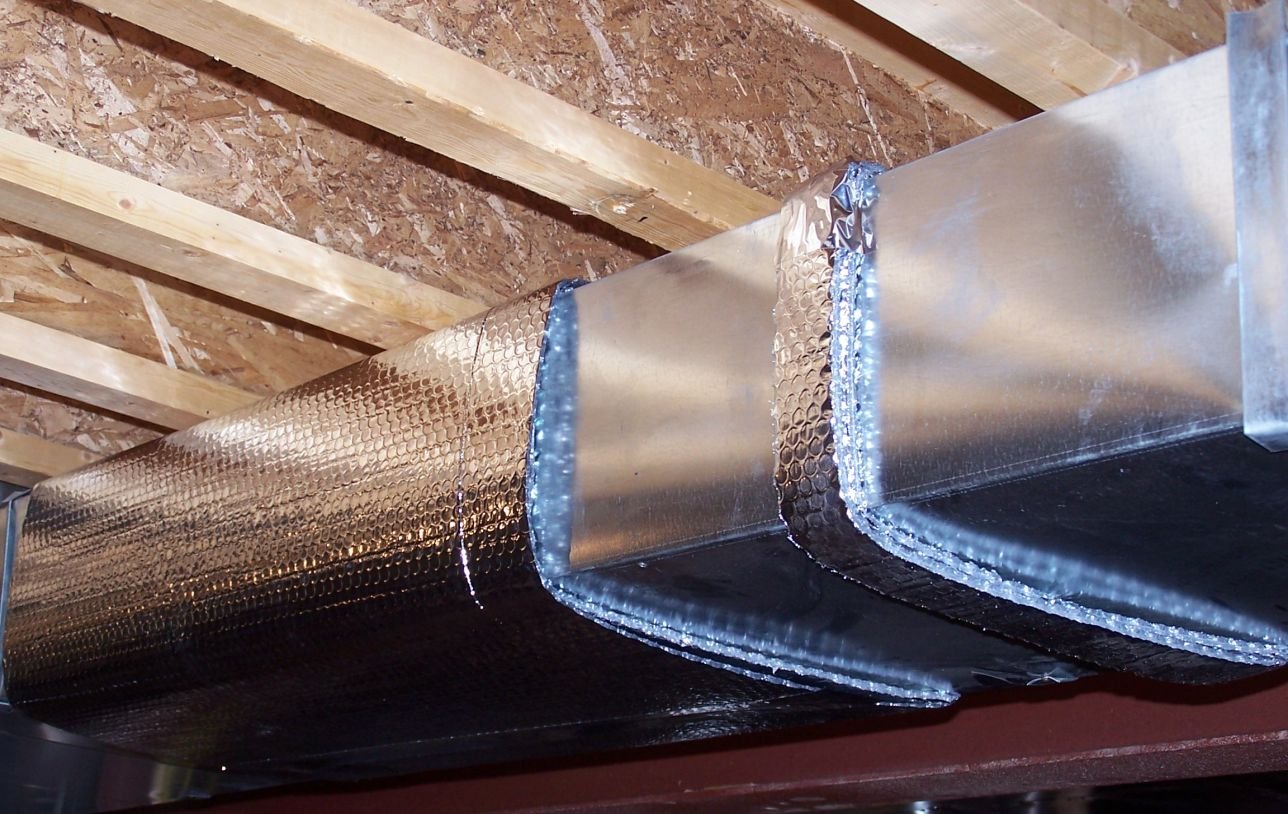One area of insulative consideration that is often overlooked when optimizing your HVAC system’s efficiency is the ductwork. Ducts may seem unimportant, but in reality they affect the performance of your HVAC system significantly. Failure to insulate your ducts results in air loss, wasted energy, and uncomfortable living environments. The silver lining is that insulating ducts can enhance your heating and cooling system’s efficiency tremendously. This article will cover everything relating to ducts, including what materials may be useful for insulation and how your home stands to benefit.
What is Duct Insulation?
There are many materials used for duct insulation, however, before we elaborate on that, it is better to understand the definition and the functional processes of duct insulation. Insulation, in essence, is the addition of duct protective layers that scope vents and HVAC ducts to restrict the movement of heat from the inner airs of the ducts to the outside surroundings. That said, this protective covering serves to retain the required temperature of the air as it passes through the ducts leading to less work being done by the HVAC machinery.
With poorly insulated ducts, the circulating air loses a considerable amount of its warm or cool temperature while being transported causing air heating and/or cooling machinery to work overtime to achieve suitable thermoregulation parameters, therefore wasting an excess amount of electrical energy.
Hence, needless to say that like most materials, insulation aids in providing a controllable environment by, in this case, limiting the expenditure of heat during winter period, or restricting heat intake during the summer. And therefore, results in less usage and increased efficiency of the HVAC system. In layman’s terms, insulating saves money while helps achieve thermal comfort.
Types of Duct Insulation Materials
When it comes to choosing the best type of insulation for your ducts, there are several options to consider. Each material has its own set of benefits and is suited to different needs, depending on your home’s specific requirements. Let’s explore the most common types of duct insulation materials.
Pre-Insulated Ducts: A Smart Choice for Maximum Efficiency

The pre insulated ducts are a solution of the modern age which has exceptional thermal performance. Such ducts have the insulation incorporated into the material which means no additional insulation layers have to be placed during the installation phase. This saves not only man hours but also makes certain that the insulation is uniformly placed throughout the ducts, making them more energy efficient.
The pre insulated ducts are especially useful in the case of brand new HVAC systems. They reduce the chances of heat loss and gain drastically to help keep the air temperature at the desired level while it circulates through the system. If there are new constructions taking place or a paradigm shift in the style of the house is needed, purchasing pre insulated ducts is an intelligent decision.
Fiberglass Insulation: A Reliable and Cost-Effective Option

Fiberglass insulation is very useful when it comes to insulating ducts. Not only is it cheap, but it is also easily accessible and has great thermal resistance. It helps by trapping air within its fibers which slow down the transfer of heat, maintaining the right temperature for the air in the ducts.
As effective as fiberglass insulation might be, it does have some cons. For one, it can be exposed to humidity which could be absorbed and render it ineffective over time while also allowing mold to grow. In addition to this, fiberglass insulation can be difficult to work with and requires the use of containment barriers to protect it from being exposed to dust and other particulates.
Air Conditioner Duct Insulation: Essential for Temperature Control

With regard to air conditioners, duct insulation plays a vital role for air conditioner duct overall efficiency. If ducts are not insulated, there are significant losses of cool air as it travels through unconditioned spaces. This causes the AC to function harder than it should, leading to high energy consumption and expensive utility costs. Proper insulation will help mitigate these losses.
Fiberglass and foam board are some of the materials that can be used for Ducted Air Conditioning insulation. Besides fiberglass and foam board, there is also rigid board available which is capable of providing protection against excessive temperature changes to ensure air conditioning system efficiency.
Duct Insulation Tape: Sealing the Gaps
Sealing tape is one of the most helpful products when it comes to ensuring duct leakage is not an issue. Gaps and cracks within the ductwork can severely impact and negate the insulation’s value creating the need for further an enhanced seal tape. This sealing tape is able to withstand high temperatures and is mainly designed to seal any seams or cut end pieces of ducts where insulation was removed.
Utilizing sealing tape ensures optimal minimum insulation is achieved meaning zero or minimal air leak that reduces efficiency is attained. Taking this simple, rapid action can improve the way the HVAC system operates significantly in a positive way.
Benefits of Duct Insulation
Duct insulation offers a wide range of benefits, both for your HVAC system and your overall comfort at home. Let’s take a look at the biggest benefits of duct insulation in a simple way.
Improved Energy Efficiency
Enhanced energy efficiency is one of the immediate results of the properly insulated ducts. Insulating your ducts decreases the conditioning air loss as it travels through the system, causing your HVAC system to do less work. As a result, your system will not have to exert as much effort heating or cooling your home which will minimize how much energy is used.
Cost Savings in the Long Run
While the initial expense associated with insulating ducts may seem excessive, the savings over a long period of time makes it worthwhile. Adequate insulation can save on energy bills by reducing overutilization of the HVAC system. In the long run, these savings will be substantial, making insulating ducts a financially smart decision for homeowners.
Enhanced Indoor Comfort
The insulated ducts maintain the comfort and steady temperature of a home. The ducts keep the home within a comfortable temperature range during winter and summer without creating hot or cold spots which enhance living conditions and minimizes the need to frequently adjust the thermostat.
Environmental Benefits
Duct insulation also helps reduce your home’s carbon footprint by improving the efficiency of your HVAC system. Since your system expends less energy in achieving a comfortable indoor atmosphere, you will be aiding in energy conservation and diminishing greenhouse emissions.
How to Install Duct Insulation: A Step-by-Step Guide
Installing duct insulation may sound intimidating, but it’s a manageable DIY project if you have the right tools and materials. Here’s an easy step-by-step guide to help you get started.
Tools and Materials You’ll Need
Before you start, gather all the tools and materials you’ll need.
- Duct insulation (fiberglass, foam board, or pre-insulated ducts)
- Duct insulation tape
- Duct sealant
- Measuring tape
- Utility knife
- Gloves and safety glasses
The Installation Process
Measure Your Ducts: Start by measuring the length and size of the ducts you want to insulate. This will give you an idea of how much insulation you’ll need.
Cut the Insulation: Using a utility knife, carefully cut your insulation to the correct length and shape to fit your ducts.
Wrap the Ducts: Begin wrapping the insulation around each duct, ensuring that there are no gaps or exposed sections. Secure the insulation in place with duct insulation tape.
Seal the Gaps: After wrapping the insulation, use duct sealant to seal any remaining gaps or seams where air might escape.
Check for Proper Coverage: Double-check that all areas of the ducts are fully insulated, especially around joints and connections.
Common Mistakes to Avoid
- Leaving Gaps: Even small gaps in your duct insulation can significantly reduce its effectiveness.
- Using the Wrong Material: Make sure to use the right material for your climate and HVAC system.
- Improper Installation: Ensure that the insulation is snug and secure to prevent air leaks.
Conclusion: Why Duct Insulation is Worth the Investment
Insulating ducts is one of the easiest steps you can take in increasing energy efficiency and comfort in your home or any commercial space. Use quality materials, work with proper installation and build up maintenance over time, and you will notice a huge difference in the performance of your HVAC system and a decrease in your expenses in energy bills.
At Airlution, we take pride in our Energy Efficiency Services that help you save power and reduce the running costs of A/C and ventilation systems. Additionally, we specialize in pre-insulated ducts, which offer unmatched solutions in mitigating thermal energy losses as well as facilitate efficient elevators within HVAC systems.
We focus on providing expert Air Conditioning Services which range from installation to repairing of air conditioning systems while ensuring components work well together through regular maintenance. Our HVAC Installation Services help in combating energy loss through the use of quality insulating products coupled with expert installation to ensure the entire living space meets comfortable standards.
We service a bigger segment of the market which includes Commercial and Industrial facilities where we install Industrial HVAC Services and components for heating, cooling, and ventilation. There are many other services we provide from HVAC ductworks, insulation, to replacing obsolete systems with newer ones and ensuring our clients receive best service and satisfaction.
FAQs:
What is insulation?
Insulation is a material that helps prevent heat loss or gain, keeping the air inside ducts at the desired temperature and improving HVAC efficiency.
Which material is used for duct insulation?
Common duct insulation materials include fiberglass, foam board, pre-insulated ducts, and duct wrap. These materials help reduce energy loss and improve system performance.
What is the best insulation for ductwork?
Fiberglass is affordable and widely used, pre-insulated ducts provide excellent efficiency, and foam board is ideal for humid environments due to its moisture resistance..
Is Fiberglass Insulation Safe for My Home?
Yes, fiberglass insulation is safe when installed properly and kept sealed. Be sure to wear protective gear when handling it.
Does Duct Insulation Help with Noise Reduction?
Yes, insulated ducts can significantly reduce the noise caused by airflow, making your HVAC system quieter.


